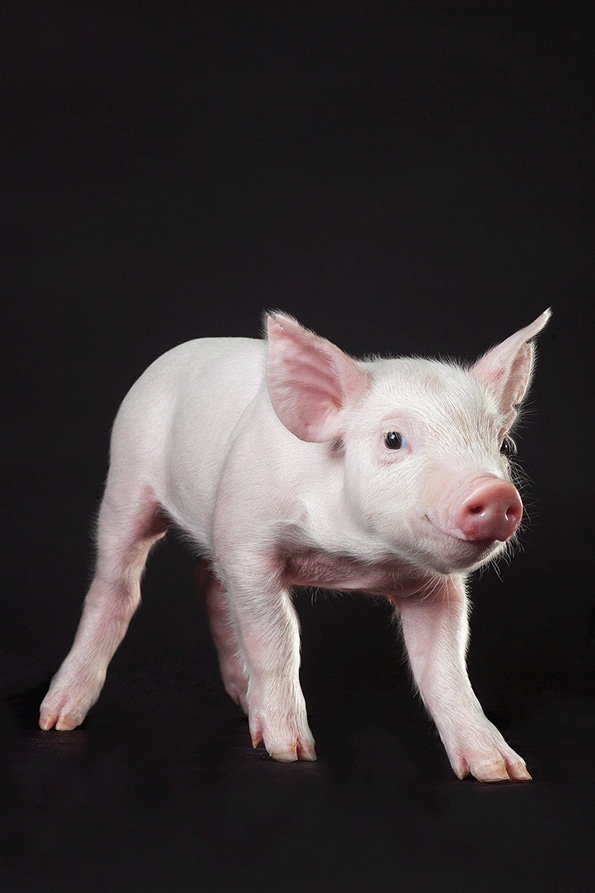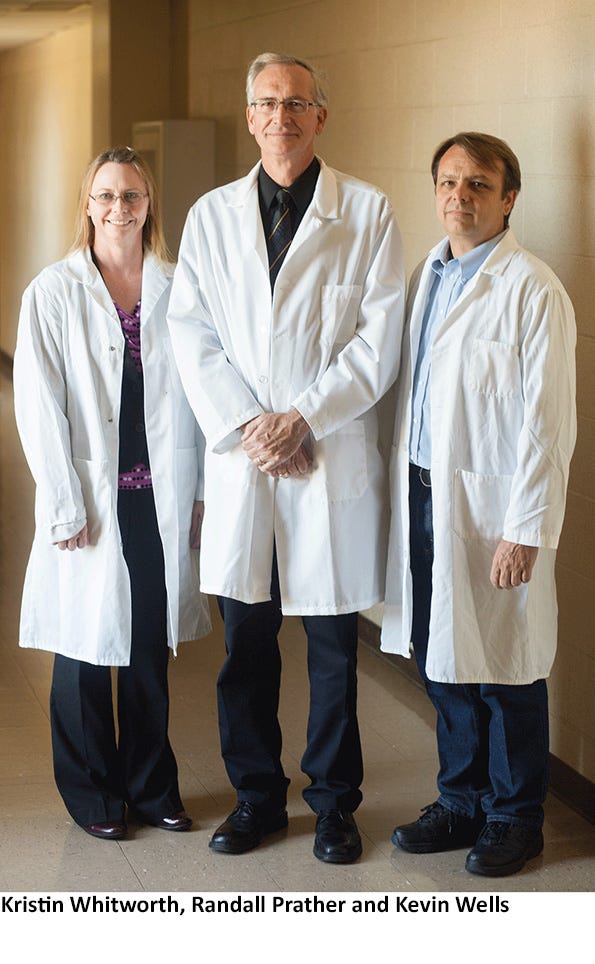April 25, 2016

Porcine reproductive and respiratory syndrome was first reported in North America in 1987 and was called the “mystery pig disease.” The virus causing this disease was identified in Europe in 1990 and named porcine reproductive and respiratory syndrome virus.
The virus replicates in alveolar macrophages (immune cells in the lungs), and animals become persistently infected. In addition, infection by PRRSV predisposes animals to other bacterial and viral pathogens. Young and growing pigs exhibit pneumonia, diarrhea and mortality of 12% to 15%. Sows and gilts have reproductive failure, late abortion, early farrowing, increased mummification of fetuses and decreased litter size. Boars have low libido, fever and low sperm counts. Vaccines have not effectively controlled the virus.
It is estimated that in North America and Europe, PRRSV results in combined losses of $6 million each day. While this number is impressive, it doesn’t take into account the emotional costs that families endure when their pigs become infected. The toll on relationships within these family-owned farms must be enormous. I remember when our family farm succumbed to a combination of the pressures of high interest rates in the late 1970s and early 1980s, and financial decisions influenced by the beginnings of Alzheimer’s disease in my father. That was an emotional experience that I don’t like to recall. However, I like to be positive and look for the silver lining. If our family farm had not failed, I would be in Kansas, and not at the University of Missouri where a preventive for PRRSV has been found. And I certainly would not be writing this article (my high school English teacher would have never believed that I now write for a living). From an industry perspective, there are at least three concerns regarding PRRSV.
From an industry perspective, there are at least three concerns regarding PRRSV.
First, there is much discussion about sustainability. For the hog industry to be sustainable, we can’t have a drain on resources like feed, labor, fuel, etc., from animals that are not productive.
Second, our food supply needs to be safe and reliable. Food security requires that we have a continual supply to meet the needs of the population.
Third, contrary to what some would have you believe, producers do place a high priority in regard to animal welfare. Nobody likes to see sick and distressed animals.
In January 2002 we published a paper that showed how we could knock out a gene in a pig. That effort was an attempt for xenotransplantation, transferring pig organs to humans whose organs were failing. It was a tour de force, but we showed that we could remove a protein from the pig’s body that caused immediate rejection of the pig organ. Around the same time, researchers began describing proteins they thought were responsible for the PRRSV entering and infecting the alveolar macrophage. Similar to the molecule on the cell surface that resulted in rejection of an organ, the molecule responsible for PRRSV infection may also be located on the surface of the cell. In June 2002 I filed a disclosure with the University of Missouri describing how we could knock out the gene responsible for susceptibility. If accomplished, there would be at least two major outcomes.
We would have unequivocally identified the receptor that is responsible for entry into the cell and infection of the pig.
We may have created an animal that would be economically viable that was resistant to PRRSV.
As with many pathogens, numerous candidates have been proposed to be the receptor for entry into the host cell. There were at least six candidates for the receptor that the PRRSV used to infect the cells. We began with sialoadhesin and worked toward knocking out this gene. The lack of funding in combination with the inefficiency of the technology to knock out the gene resulted in a rather long timeline. Our founder males were finally born in January 2011. The males were heterozygous, i.e., they still had one functional copy of the gene. When these boars reached puberty, we bred them to wild-type (not genetically modified) females to produce both males and females that had one copy knocked out. Then we could mate the half siblings together to produce animals in which both copies of sialoadhesin were knocked out. I drove the animals to Bob Rowland’s laboratory at Kansas State University where they were challenged with a PRRSV isolate.
I should take a moment and explain that Rowland’s group has the infrastructure and personnel set up at KSU designed to test for resistance to PRRSV. His group has acquired a variety of genetics from all over the country and has challenged over 3,000 pigs. Up until this time, he had never found an animal that was resistant to the PRRSV.
Unfortunately the wild-type control pigs and the sialoadhesin knockout pigs all contracted the PRRSV. We finally published these results in 2013, almost 11 years after the conception of the idea.
We then turned our attention to CD163. The project moved forward slowly until Kevin Wells here at the University of Missouri read about a new method to genetically edit the genome. This method, called CRISPR/Cas9, is repurposed from a bacterial anti-viral system. This system can target a specific region of the genome and cut it. When the cut in the DNA is repaired, it often results in making a mistake and alters a few bases of the genome (letters of the DNA).
Under the direction of Wells, Kristin Whitworth implemented the new technology. The newer technology worked better than we could have imagined and now we could make genetic change at relative lightning speed. In this case, in less than six months we had male and female founder pigs whose CD163 gene was edited. While we were unable to obtain federal research support for this project, Genus plc stepped up and provided most of the funding for creating the pigs, and all the funding for the subsequent viral challenge. When the founder gene-edited animals reached puberty, they were bred to produce offspring that could be challenged with PRRSV. Again, we reached out to Rowland and his group at KSU.
In March of 2015, I again made the drive to Manhattan to deliver the next group of pigs. We had only a handful of gene-edited pigs, and I knew that Rowland wanted more to be able to detect differences. As a colleague of mine said, “shoot the rocket,” and let’s see what we get. The pigs had random ear tag numbers, so Rowland’s group did not know which pigs were edited and which were wild-type. As I drove back home through the beautiful springtime Flint Hill Prairie of eastern Kansas, I wondered if it would really work.
Rowland left his group in charge and went to a much-needed vacation in Florida. A few days later, I received an email from Rowland from the beach in Florida. The email was forwarded from his group at KSU. The blood samples collected four days after infection of the pigs showed something they had never seen before, i.e., some of the animals did not have any PRRS virus in their blood.
The person running the assay hadn’t seen anything like it and wasn’t even sure what they had. The positive and negative controls worked, but some pigs were negative. To keep the study blind, the person running the assay was told with a straight face, “This is OK, let’s see the next time point.”
The email that Rowland forwarded identified the ear tag numbers of the three animals that were PRRSV negative, and I saw immediately that these were the edited pigs that should have CD163 knocked out.
The wild-type and CD163-edited animals were co-housed and the wild-type pigs were coughing on everyone else. However, in contrast to the control pigs these three gene-edited pigs did not cough and did not run a fever. Also in contrast to the wild-type pigs, they had no virus in their blood. The pigs’ lungs were evaluated at the end of the study, and as expected, the wild-type pigs had lung lesions consistent with PRRSV infection. In contrast, the lungs of the gene-edited pigs looked perfectly normal. The difference between these animals was so distinct that Rowland now says that all he needs is one animal to determine if the gene-edit results in resistance.
The pig genome probably contains about 3 billion bases (letters of the genome). There are two copies of each gene, one from the sire and one from the dam. In one of the PRRSV-resistant pigs, one allele (copy of the gene) of CD163 had seven extra bases, and the other allele had 11 bases deleted. These very minor changes in the genome represent 18 bases out of 3 billion, or 0.0000006%.
Typically genetically engineered organisms contain transgenes. A transgene is a gene from another species placed into the genome of the host animal or plant. These transgenes can contain thousands of bases (letters) that code for foreign protein(s) (proteins from another species). In contrast, the CD163-edited pigs have a handful of bases altered (added or deleted); and in contrast to a transgene, these pigs have a protein that is simply altered or missing.
The CD163-edited pigs have been raised in a research setting and not a production setting. Nevertheless, they appear perfectly healthy, grow at rates similar to pigs in production, and reproduce normally. While this sounds great, a number of things must happen before producers can expect to acquire similar animals on their farms. First a similar edit needs to be introduced into elite genetics, and then it remains to be shown that there are no unintended deleterious effects on production (health, growth, feed efficiency, welfare, etc.). The Food and Drug Administration will want to evaluate the effects of the edits in the animals. Currently, the FDA treats genetically engineered animals as a new drug — an incredibly high standard.
Resistance to PRRSV is not the only gene edit on the horizon. Other gene edits have been used in dairy cattle and resulted in animals that do not grown horns. Again, similar to animals not getting sick from PRRSV, polled dairy cattle created by gene editing addresses an economic and an animal welfare issue. There are likely other genetic edits that can be made to domestic animals to address other welfare issues, to increase production, to provide resistance to other diseases, and maybe even to alter the animal so that it better meets the nutritional needs of humans.
These, and other edits, can help contribute to sustainability and world food security. Healthier and more productive animals are everyone’s goal. I would go as far to argue that we have a moral obligation to consider genetic edits as options that would prevent animals from becoming sick, underperforming or dying.
The technology to introduce precise edits into the genome has progressed rapidly. The genetic edits that we introduced are minor. I’m hopeful that these, and similar, genetic edits can clear the regulatory hurdles and begin to make a difference to the animals we raise, to the people who produce our food and to supplying food to an exponentially growing population.
You May Also Like



